Cool stuff from Japan: Plastic food models used for nutrition education
You're probably already familiar with the sometimes disturbingly lifelike, plastic or silicone models of food that are used as window displays in many Japanese restaurants, both in Japan and around the world. They are great visual aids for ordering unfamiliar food. Here's a typical display of such models at a ramen shop:
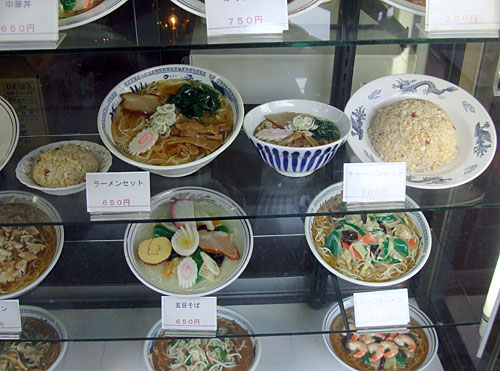
And here's one at a famous curry and yoshoku restaurant in Shinjuku called Nakamuraya, showing their East-West fusion type desserts:
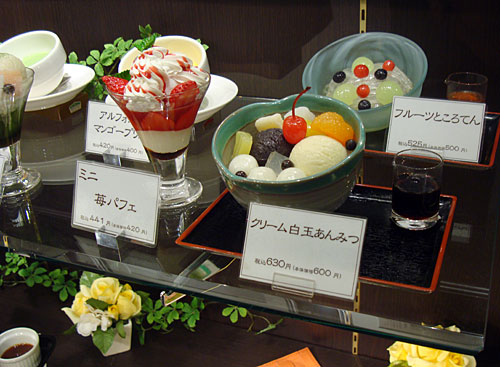
And here is...well, do you see something different? Instead of prices, the tags show nutritional information.
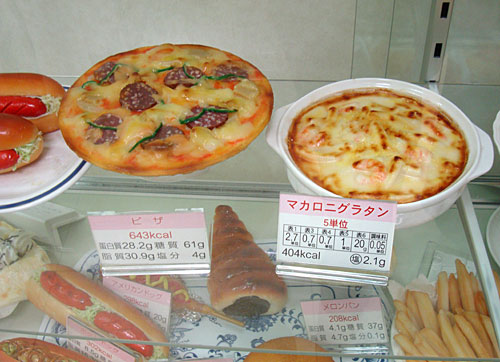
That's because this display is not in front of a restaurant. It's in the Nutrition Counseling Room at the hospital my mother is in at the moment. The very nice and sweet dietician told us that the models are made by a famous maker of such food models, under the strict supervision of the hospital to ensure accuracy, and are as realistic in terms of portion size and so on as possible.
Here's another view of the nutrition counseling room. In the foreground you see a set of plastic drawers that are labeled by the type of food model they hold. They have single-serving versions of various food. In the background, where the lady in the white lab coat is (that's the dietician who counseled my mother) is a glass display case that holds various commonly eaten dishes.
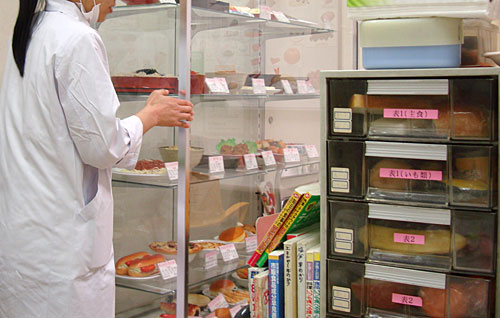
I guess listening to someone explaining the nutritional value of a food is best if you're looking at the actual food, but these realistic models are the next best thing -- plus, they can be stored and reused and taken out again and again without worrying about spoilage.
Here's the dietician holding up a bowl of miso soup. The lighting in these photos is not the best (it was after all, hospital lighting) but in person, except for the fact that the surface wasn't moving, it looked just like a bowl of miso soup!
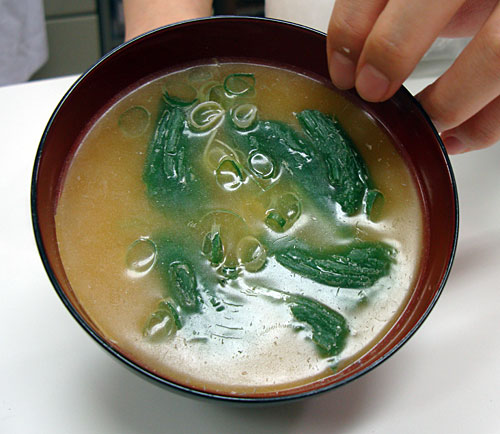
Here's one of the meal displays in the glass case, in this case a plate of spaghetti with meat sauce. The numbers indicate how many units of a certain type of nutrition it has on a typical food chart used mainly for diabetics, since it seems they are the ones that need the most guidance (1 unit is 80 calories). The bottom row shows the total calories (605) and sodium (2.5g). And that's for a smallish Japanese-restaurant portion.
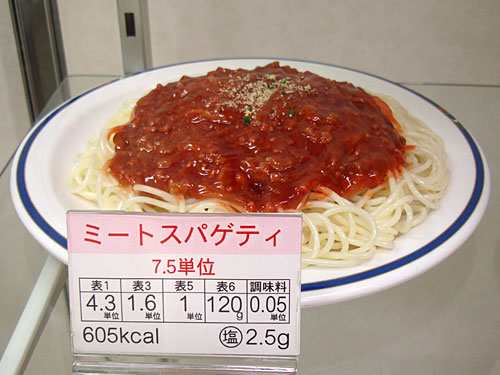
The bottom shelf of the display case had various snack foods and fast foods, which had the actual nutritional breakdown rather than units on their labels. For instance, here in the middle is a "large" sized portion of fast food french fries (called fried potatoes in Japan). It has 4.1g of protein, 34g of carbohydrates, 20.5g of fat, 2g salt, and...338 calories! The apple pie on the right is worse - 380 calories, most of it carbs and fat. Pies will have to be occasional treats from now on for me... ;_;
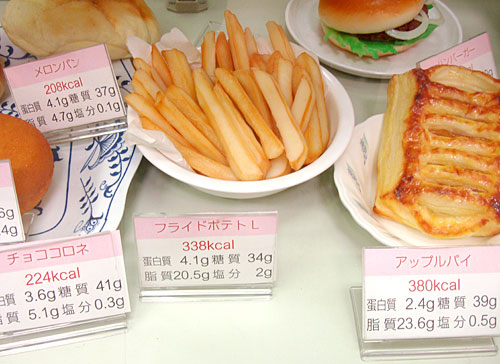
Here is an 80 calorie pat of butter, on a standard tablespoon-sized (15ml) measuring spoon. Seeing it like this, and holding it in your hand, really has impact. Incidentally, food units in Japan are based on 80 calories, because that happens to be the approximate calorie count of a lot of foods - 1/2 a standard bowl of cooked white rice, 1 egg, 1/2 slice of bread, etc.
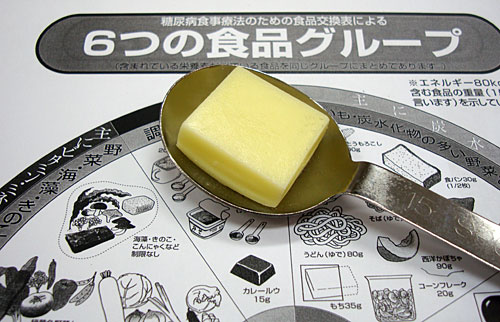
When it comes to sweet things, you really see how sparingly you should be eating them if you're watching your weight. This tiny sliver (about 2 inches / 5cm long and maybe 1/2 inch / less than 1cm thick at the widest point) of strawberries and cream filled spongecake, called 'strawberry shortcake' erroneously in Japan (it's the most popular kind of cake here by the way) is 80 calories. So a standard slice of cake is more than 400 calories. With buttercream icing, it would be way higher. I knew this kind of thing before but as I've said, seeing a three-dimensional representation leaves a much bigger impression than reading it in some calorie chart, or even seeing pictures.
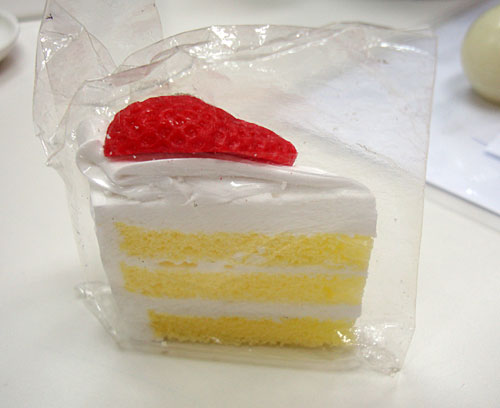
Beware how you cook your fish!
My favorite set of food models was one that showed how various cooking methods affect the calorie count. Here's a model of a piece of uncooked fish (mackerel or something) - I think it was 70 grams, or about 2 ounces. It's 80 calories.
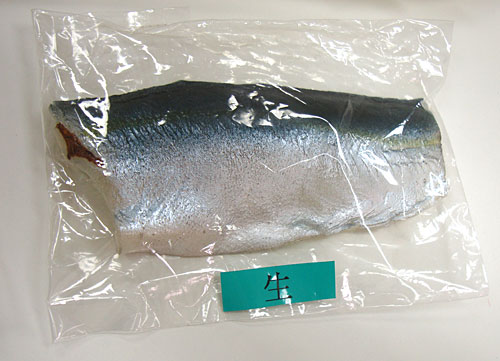
Dry grilled or panfried with just salt, it's the same amount of calories with a bit of added salt of course. (And for oily fish, plain grilling is one of the best cooking methods anyway.) So here's the grilled fish model. Looked actually appetizing!
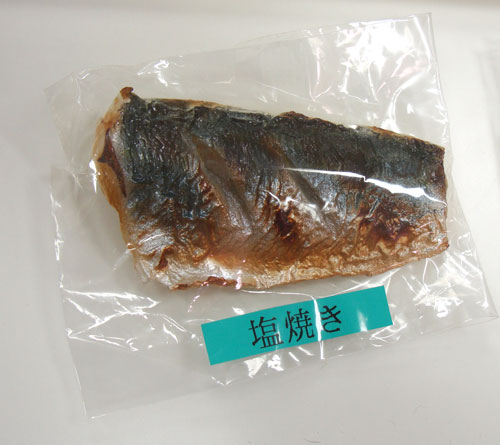
But once you cook the fish with fat and other things, the calorie count shoots up. This tray shows three different ways of cooking the fish, together with the amount of oil or butter, flour, egg, breadcrumbs etc. that are added to a typical piece of fish. From right to left, you have a meuniere (coated in flour and panfried with a bit of butter and oil) at 134 calories; karaage (coated in flour and deep fried in oil) at 145 calories; and finally _furai) (coated in flour and egg, dipped in bread crumbs, and deep fried) at a whopping 181 calories! For one tiny bit of fish!
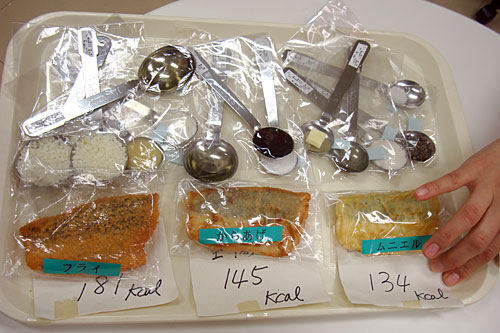
I think using these food models is a fantastic way of driving home the point about portion sizes and cooking methods. Wouldn't it be great if they were used all around the world, especially in schools to teach kids? One drawback is that these very realistic and accurate models are expensive, since the originals from which the casts are made are handcrafted. Still, I do wish that use of these models could someday become universal in nutrition education everywhere.
I've posted some more photos of the nutritional food models in this flickr set.
(And by the way, great news: Not only is my mother getting discharged from the hospital later today, she was told by the dietician that she can basically eat anything she wants, as long as it's healthy and balanced. After years of having to watch what she ate all the time, she's absolutely ecstatic.)
If you enjoyed this article, please consider becoming my patron via Patreon. ^_^

 Welcome to Just Hungry, where we serve authentic Japanese recipes and more! I'm
Welcome to Just Hungry, where we serve authentic Japanese recipes and more! I'm 













Comments
Lexi
26 January, 2010 - 23:29
Permalink
Re: Cool stuff from Japan: Plastic food models used for ...
Wow, this is really fascinating, I love these models - such attention to detail! thanks for sharing!
And great news about your Mum :)
MT
27 January, 2010 - 04:32
Permalink
Re: Cool stuff from Japan: Plastic food models used for ...
This is great stuff!
I'm happy to hear about your mother *hug* thanks for letting us know Maki
God bless you and family
Japan Australia
27 January, 2010 - 07:30
Permalink
Re: Cool stuff from Japan: Plastic food models used for ...
Those plastic food models are great, aren`t they? I know a shop in Mino Kamo Gifu, Japan that sells keyrings with the plastic model food on them. I grabbed a couple of tempura and sushi keyrings for friends before I came back home.
Japan Australia
Lola
27 January, 2010 - 09:01
Permalink
Re: Cool stuff from Japan: Plastic food models used for ...
I'm a student dietitian and have seen these in the UK as well, for the same purpose. However, they are a pale shadow of the quality of the Japanese ones, looking barely like the food they are supposed to represent. We spent some time trying to distinguish between fish, potato and macaroni cheese. They are that bad!
maki
27 January, 2010 - 10:13
Permalink
Re: Cool stuff from Japan: Plastic food models used for ...
I do think it's the amazing realism of these models that makes such an impact -- at least it did for me! I'm already a lot more aware of what I'm eating...
Loretta
27 January, 2010 - 12:53
Permalink
Re: Cool stuff from Japan: Plastic food models used for ...
(wiping a tear from my eye)
Maki, that's so wonderful about your mother! And I'm so excited for both of you that you'll be able to do more things together in the coming weeks. Fantastic news and a great start to the year!
It's a real privilege to see these models in this educational context - when you're not feeling well and are pumped up with drugs, reading brochures and literature can be mind-numbing and, somehow, indigestible. What an excellent way to get this information across.
And how nice of the hospital staff to allow you to document these learning aids, it's obvious your mum has been in good hands.
maki
27 January, 2010 - 13:19
Permalink
Re: Cool stuff from Japan: Plastic food models used for ...
Thank you Loretta :)
5oclockteaspoon
27 January, 2010 - 19:50
Permalink
Re: Cool stuff from Japan: Plastic food models used for ...
Best wishes for your mother. I really enjoyed this post. Do you know the name of the person or company who manufactures these models?
Thanks!
Lillian
28 January, 2010 - 00:49
Permalink
Re: Cool stuff from Japan: Plastic food models used for ...
When I was a student dietitian in the US and worked at the Cooperative Extension, we took a huge plastic Food Guide Pyramid full of plastic foods to the local public school to teach. They were very realistic, and the kids loved it! Not as much variety as this, to be sure, but still they are very expensive. Though my favorite was the test tubes full of sugar and shortening that represented the amounts in soda and fast food...
MN
28 January, 2010 - 01:06
Permalink
Re: Cool stuff from Japan: Plastic food models used for ...
よかった!! I'm really glad that your mother is getting out of the hospital! I'm looking forward to her next guest post as well.
I'm looking forward to reading the rest of your in Japan posts, even though I'm headed back to the UK myself tomorrow.
Will you do a mini sort of 'Yokohama or Tokyo eating blitz' like you did with Paris? I know they're both massive, but just like visiting a little place somewhere. I went to a Tonkatsu restaurant in Ikebukuro which made their own tonkatsu sauce (sadly I didn't buy any but I'm thinking about going back to get it today...) and I thought that was kind of neat.
pii_bii
28 January, 2010 - 19:05
Permalink
Re: Cool stuff from Japan: Plastic food models used for ...
So glad to hear about your mother, Maki. It's great that she can enjoy a wide range of meals now without fear. Colitis is a horrible illness, so I'm glad she has got through it.
I am really enjoying your uploads on your Flickr - they seem to come so thick and fast!
I can't believe when I look at plastic food models, even knowing that they're not real, my mouth still waters! It does seem to be a really good educational tool.
erisgrrrl
29 January, 2010 - 03:17
Permalink
Re: Cool stuff from Japan: Plastic food models used for ...
That's really cool!!! And I totally agree that those would be stellar for teaching kids nutrition! Especially small kids who just have food handed to them ...and older teenagers who are making choices.
Most importantly I'm glad your mom is okay! :D
Naimah
29 January, 2010 - 13:36
Permalink
Re: Cool stuff from Japan: Plastic food models used for ...
the portions look so lifelike! lots of attention to detail was given.
Naimah
Swati
3 February, 2010 - 11:32
Permalink
Food models
Glad to hear the news about your mother.
The models look really life like - had I not read your post, I would have thought these were real food photos. And I think they ought to be more widely available and less expensive. Even if the original is handcrafted, the subsequent moulds surely are not so mass production should bring down costs. If only someone would market these as toys, there would be more demand than just as educational aids (which incidentally is a great use!)
Bretigne
2 April, 2010 - 20:00
Permalink
Re: Cool stuff from Japan: Plastic food models used for ...
I just looked at your Flickr page and saw the pictures from the Studio Ghibli Museum. I am so jealous!!!!! Thanks for posting them! I hope to take my kids there someday.
anon.
12 February, 2012 - 11:26
Permalink
Re: Cool stuff from Japan: Plastic food models used for ...
hi, where can i buy this food models? i need this for my major subject. Thank you :)
Justin
26 June, 2012 - 11:35
Permalink
Re: Cool stuff from Japan: Plastic food models used for ...
If you are looking for an online shop that sells [Made in Japan] fake food related items in English and ships all over the world, you may want to check out Fake Food Japan: http://fakefoodjapan.com/
All the best,
Justin